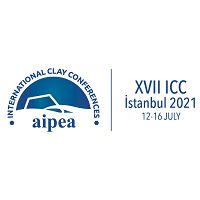Sessions related to CZ Science at the 2021 International Clay Conference
The Clay Science Society (Turkey) and The Clay Minerals Society (USA) will be co-hosting the 17th International Clay Conference 2021 (17th ICC 2021) in İstanbul, Turkey. The scientific program of the 17th ICC 2021 will bring together, as it does every four years, scientists from different disciplines related to clays and clay minerals. The program will consist of technical sessions of oral and poster presentations and keynote speakers.
Meeting website: http://icc.aipea.org
Contact Conference Chairs by e-mail: chair@17icc.org
Important Dates:
- November 15, 2020: Opening of abstract submission
- February 15, 2021: Abstract submission ends
- March 15, 2021: Early registration ends
- March 28, 2021: Abstract Acceptance
- July 10-11, 2021: Pre-conference workshops (ASYS, CMS, AIPEA)
- July 12-16, 2021: Conference and one day social program
- July 17-18, 2021: Post-conference one and/or two days field trips
Session calls related to CZ Science:
No. 5: Soil minerals in connection with pedogenic processes
Conveners: Stahr, K., Kadir, S., Kapur, S., Costantini, E., Bronnikova, M.
Most pedogenic processes occur under a specific soil/sedimentary environment. This is characterised by the chemical constitution as well as the land use, water, and temperature regime. Weathering, re-crystallization and all transformations need a certain time to develop in soil. Therefore, in most soils we can identify an initial and a derived final mineral constitution. The advantage of the transformation and process-oriented mineral development characterizes the progress of pedogenesis. Pedogenic palygorskite developing on and/or around smectite by precipitation and/or transformation or vice versa bears utmost significance in designating the type of pedogenetic process along with the climatic conditions of the environment. Kaolinite neoformed in the silica-alumina rich matrices of basaltic rocks are also the indicators of initial/primary pedogenesis.
Ultimately, this session will cover pedogenesis (soil/clay mineral formation) in undisturbed (forestal ecosystems/biomes) and archaeo-/recently cultivated soil ecosystems, i.e., the Red Mediterranean Soils (Calcisols, Luvisols and Leptosols) alongside the Technosols and Anthrosols developed in archaeological excavaton sites. Research on initial pedogenic evidence in archaeological artefeacts is also part of our interest.
No. 12: Soil mineral quantification -from poorly crystalline phases and interstratified soil clay minerals to digital soil mineralogy
Conveners: Dietel, J., Dohrmann, R., Georgiadis, A., Hillier, S., Hubert, F., Mikutta, C.
Soils have multi-mineral compositions almost invariably including poorly crystalline and/or highly defective clay phases exhibiting high spatial heterogeneity. Understanding biogeochemical processes occurring in soils requires detailed mineral identification, quantification, and distribution information, and this has been a longstanding challenge. Recent developments have begun to provide more realistic quantitative descriptions of soil (clay) mineralogy. Examples from XRD are disordering models developed for Rietveld refinement, XRD profile modelling and high throughput full pattern fitting. This session seeks contributions to help define
what further improvements are possible and desired for the characterization of poorly crystalline phases, hydroxy-interlayered minerals and interstratified soil clay minerals and how various new approaches may be integrated. We invite contributions of studies that highlight the use of quantitative data and interdisciplinary examples such as digital soil mineralogy and chronosequence data for a quantitative assessment of soil mineralogy.
No. 15: Interaction between clay minerals and organic carbon: from natural clay-carbon compound to hybrid materials
Convenors: Liu, D., Theng, B.K.G., Xiandong, L., Hongjuan, S., Lv, G.
This proposal for a thematic session in the 17th ICC is with regard to the interaction between clay minerals (CM) and organic carbon (OC). The interface reactions between CM and OC, as well as their products, organoclay, are widely present in natural environments such as soil, rock, water, and aerosol. The reactions, such as sorption and catalysis of OC occur on/by CM play an important role in the terrestrial and marine
carbon cycle. The effects of CM for OC protection (e.g., avoiding its decomposition by microorganisms) and for OC consumption (such as by catalysis) have been attracting increasing attention from many research domains focusing on mineralogy, soil science, environmental science, geochemistry, and ecology. Moreover, synthetic organoclay has found promising applications in the field of hybrid materials. Therefore, the
abovementioned session aiming at provoking more research and discussion in interactions between CM and OC will be of general interest in the clay community.
No. 24: The role of clays in critical zone architecture and function
Convenors: Schroeder, P.A., Lanson, B.
The complex process of argillic/clay horizon formation in the below-ground critical zone (CZ) serves as “Nature’s clay factory” and controls CZ architecture and function. These clays and clay minerals have a profound influence on hydrologic, ecologic, geochemical, and geomorphic land functions, over both geologic and human time scales, thereby helping ecosystems services and human wellbeing. This thematic session seeks to bring together the new generation of CZ-networks and field-based clay mineral studies used in concert with other CZ network observations to validate forecasting and hindcasting CZ function. To determine further the role of clays and clay minerals in the CZ and develop such clay factory models, this session further seeks contributions, including model laboratory experiments, that characterize and identify the dynamic role of clays in the CZ, which will help to better understand of the fate of nutrients, contaminants, and water resources in the CZ.
ICC 2021 Banner
News Category:
RESEARCH |
OPPORTUNITIES
Explore Further



